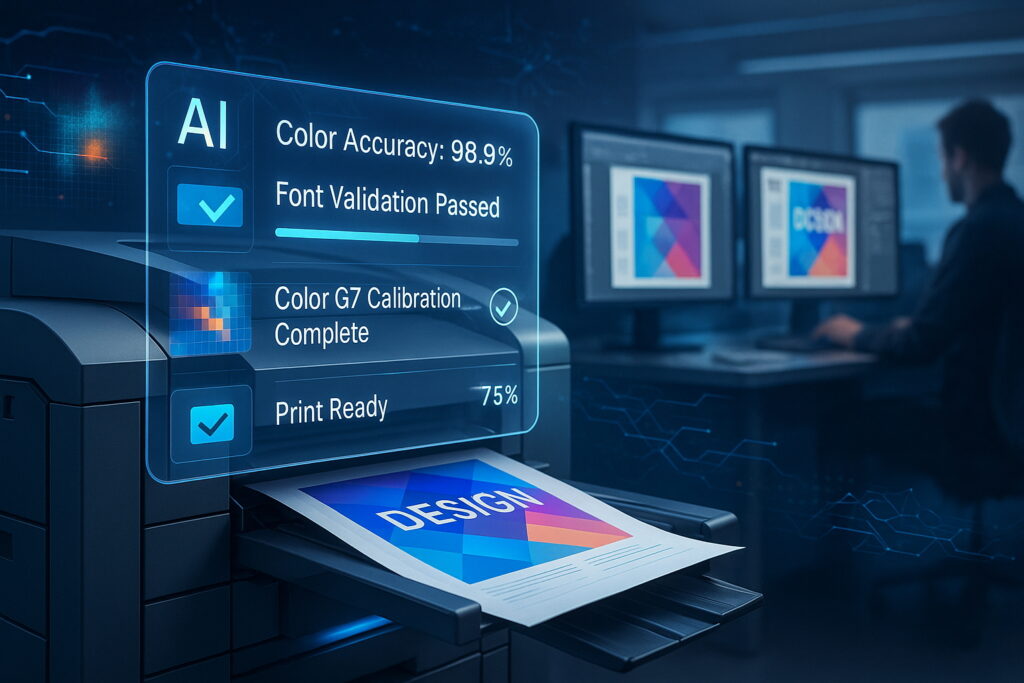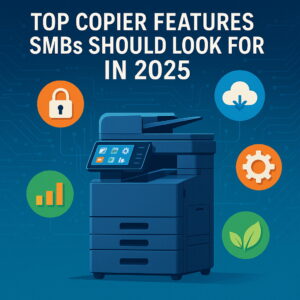AI-Driven Real-Time Print Analytics and Design Optimization: Beyond Predictive Maintenance
AI is not just a tech buzzword anymore—it’s embedded in how the most efficient organizations manage and optimize their print operations. For years, discussions around AI in the print space have centered on predictive maintenance. That’s valuable, sure—but it only scratches the surface. Today, artificial intelligence plays a critical role in improving print quality, design accuracy, and operational efficiency. From real-time image analysis and color correction to automated scheduling and layout adjustments, AI-driven tools are transforming how print jobs are designed, managed, and executed. This blog answers the question: How can AI-powered real-time analytics and design optimization tools elevate print operations beyond simple device upkeep? Let’s dig deep. Real-time print analytics refers to the immediate collection and analysis of data from print operations. AI systems monitor variables like: By analyzing this data continuously, AI tools can recommend (or automatically apply) adjustments, ensuring quality, efficiency, and cost control on the fly. Think of it as AI acting like a second set of eyes across every job, every machine, and every run. AI systems can evaluate scanned outputs in real time and compare them to the original design files. If a discrepancy is found—say a shift in color calibration or a blurry logo—the system flags it immediately or corrects it automatically. For example, WTPBiz highlights how AI can detect: In the past, these errors might have slipped through until the client noticed. With AI, they’re caught as they happen—or even before they hit the page. Consistent color output is notoriously difficult to maintain, especially across different devices or substrates. AI tools assist by automating ICC profile selection, making G7 calibration adjustments in real time, and ensuring precise color matching for every print job. No more manually tweaking settings or rerunning jobs. The system learns from each job and optimizes the next. AI can cross-check fonts used in the print design with approved brand templates. If a font substitution occurs (a common issue when PDFs are created with missing fonts), AI can recommend the right font or flag it for human review. Similarly, AI helps optimize layout and spacing to reduce print misalignment, ensuring your documents look professional and polished every time. Beyond quality control, AI is a powerful engine for workflow automation and resource optimization. AI can analyze incoming jobs and machine availability to determine the most efficient production schedule. It considers: Instead of relying on human operators to queue jobs manually, AI prioritizes tasks dynamically and routes them to the best available device. This not only reduces downtime but also ensures that urgent jobs get out the door faster, without compromising quality. AI also helps manage consumables (like paper, toner, and substrates) by tracking usage patterns and predicting when resupplies are needed. That insight can be tied into procurement systems or MPS (Managed Print Services) platforms for automated reordering. Imagine a system that prevents paper jams by noticing when humidity or substrate mismatch is likely to cause issues, before they do. Web-to-print platforms have become increasingly common for businesses with distributed teams or multi-location operations. AI augments these systems by: For example, a franchise ordering updated signage through a portal won’t need to worry about sizing or resolution errors—the AI catches it and auto-corrects or offers alternatives. This drives faster approvals and fewer reprints. Yes—and not just junior designers either. AI-powered plugins for design tools like Adobe Illustrator and InDesign can: Rather than replacing designers, AI becomes a creative partner, removing the repetitive grunt work so humans can focus on higher-level strategy. Here’s where things get serious for business owners and IT managers. AI can significantly reduce the total cost of ownership (TCO) of print infrastructure by: Let’s consider a hypothetical scenario: A regional healthcare provider uses AI-driven print analytics to manage patient intake forms across multiple clinics. By analyzing real-time performance across MFPs, they discover that certain machines are consistently slower and causing delays. The AI platform re-routes jobs to higher-performing devices, while flagging the underperformers for maintenance. They also reduce toner usage by optimizing font settings and standardizing layouts—saving $4,800 annually in supplies. That’s not magic—it’s math, powered by machine learning. Security is often an afterthought in print environments, but not with AI in place. AI-enhanced print infrastructure can monitor for anomalies that may indicate: It’s part of a broader zero-trust security strategy—an area where Doceo specializes, especially when deploying secure MPS and fleet-wide print policies. AI doesn’t work in a vacuum. To reap the benefits, businesses must: Most importantly, they need a partner who understands both the tech and the business. At Doceo, we’ve helped organizations across industries implement AI-enhanced print workflows—from design integrity to production scalability. Whether you’re looking to improve output consistency, reduce waste, or empower your design team with smarter tools, we tailor a solution to match your goals. Our experts don’t just drop off a product—they become a strategic part of your print and IT evolution. Want to see how AI can optimize your print workflows and boost your bottom line? Schedule a personalized print workflow assessment with Doceo today. 📞 Call: 888-757-6626 🌐 Visit: www.mydoceo.com 📍 Find your nearest location: Doceo Locations 🔗 Connect: LinkedIn – Doceo Doceo: Proven People. Proven Results.

Is AI Really Changing Print—Or Is It Just Buzz?
What Is Real-Time Print Analytics?
How AI Ensures Design Accuracy and Print Consistency
1. AI-Powered Image Analysis: Spotting Issues Before You Do
2. Color Management and G7 Compliance Made Easier
3. Font and Layout Validation
How AI Boosts Print Production Efficiency
1. Automated Scheduling and Load Balancing
2. Resource Allocation Optimization
What About Integration With Web-to-Print Platforms?
Can AI Really Assist Designers?
What Are the ROI and Efficiency Gains?
Where Does Security Fit In?
So, What’s the Catch?
How Doceo Helps You Leverage AI for Print Success
Next Steps




